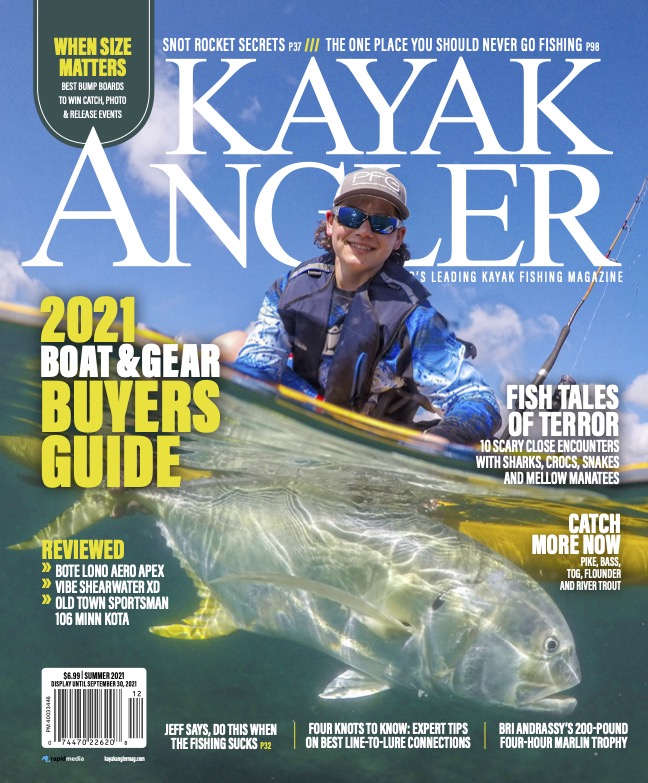Just a few years ago, kayak fishing tournaments were basking in the glow of good times with good people. Then, money started to enter the equation and the temptation to cheat became overwhelming for some. Now, tournaments are increasingly cracking down on the use of plastic measuring boards that can be modified to give an unfair advantage. For your next big event, make sure you carry an approved bump board or risk losing it all.
Tournaments Reckon with Bump Boards
The wake-up call came a few years back when the fledgling tournament trail was rocked by a series of cheating scandals. Tournament directors, despite their best efforts, seemed to struggle to keep ahead of accused cheaters as one incident after another was uncovered.

The culprit is the measuring board. To get an accurate reading of a fish’s length, anglers use a measuring device called a bump board, a plastic measuring board with a wall at one end. To measure the fish, place its nose on the wall and read the measurement at the tail.
Since kayak tournaments use a catch-photo-release format, the measuring board must be accurate. When an angler catches a fish, he takes a photo of the fish on the measuring board and then uploads the photo to a smartphone app. Tournament officials use the photos to determine who catches the biggest fish and wins all the marbles. If the measuring board isn’t reliable, the whole system falls apart.
Mandating Metal Measuring Boards
As a result, several tournaments took the lead in requiring metal measuring boards by Ketch Products. AJ McWhorter, tournament director of the Hobie Bass Open Series (BOS) explains, “We’ve learned over the years, the plastic boards allow different types of manipulation and can create questions of accuracy,” he says.
Tournament directors test every board on the market and evaluate each for accuracy. McWhorter says, “We focus on the construction, markings, accuracy, ability to manipulate, availability and overall functionality.”
So far, the Ketch boards are the only ones to pass muster with BOS. He says, “Ensuring reliable results means removing tools that have proven inconsistent over the years and working with boards that eliminate some of biggest issues we have in CPR-style events.”
Tournament anglers have several Ketch boards to choose from. The CNC machined aluminum can’t be cut, glued or bent. The numbers are etched into the metal and marked with contrasting colors. A wide cradle and pinned dam offer the most accurate measurement. But, these premium features come at a price.
The Ketch bump boards costs three times as much as plastic competitors. And the metal board doesn’t float. But it does have holes to attach a tether. The Ketch board doesn’t fold to fit in the kayak, either. Anglers have to find a place to store a 24- to 36-inch board in a small plastic boat.
VIEW ALL FISHING RULERS & TAPES SHOP BUMP BOARDS ON AMAZON
A Plastic Board May Float Your Boat
While Ketch bump boards are required for big-money tournaments, they aren’t the most practical for fun fishing. If you’re looking for a measuring board for bragging rights, then a plastic model may be a better fit. And, online and local tournaments still allow these boards.
In addition to fishing saltwater and freshwater tournaments, Kayak Angler contributor Chris Castro likes to show off for his friends and fans on his Next Level Fishing TV YouTube channel. “I’ve used bump boards as a competitor, weighmaster and for personal record keeping,” he says.
Castro says accuracy is the first requirement for a bump board. “It should at least have quarter-inch measurements,” he says. Beyond that, Castro looks for a board that is portable, tough and floats.
The original bump board by Hawg Trough became ubiquitous in the early days of kayak fishing. The simple, one-piece measuring board is cheap, light and customizable with a company or club logo. At Hobie BOS, McWhorter says, “The Hawg Trough has allowed many anglers to get in on the competitive scene and remains the foundation the sport was built on.”
But the Hawg Trough doesn’t float and it is easy to bend or cut to alter the measurements. Chris Castro says the biggest advancements have come in portability and reliability. For a better fit in the kayak, he looks for a board that can fold. To maintain accuracy, a folding board is reinforced to keep it flat under the weight of a fish.
To improve accuracy, Castro looks for a board with easy-to-read markings. He likes to darken the measurements so he can easily see them in a photograph.
The best thing about plastic bump boards is they float. Whether adding foam floatation or the board is inherently buoyant, if the measuring board goes overboard, it’s easy to recover. Castro likes YakGear’s Fish Stik. “It checks all the boxes,” he says.
Don’t Get Bumped for the Wrong Bump Board
While a metal measuring board is required for tournament accuracy, most anglers are going with a folding, floating plastic bump board that is easier to carry and use. Castro laughs and points out, “the measurement is for bragging rights, who’s going to argue about an eighth of an inch?”

Make sure your catch counts with an approved bump board. | Feature photo: Matt Charette







Or….. the tournament director could use the FishDonkey App which has video capability, allowing for the angler to lift the fish off the board, exposing the board to prove it’s validity.